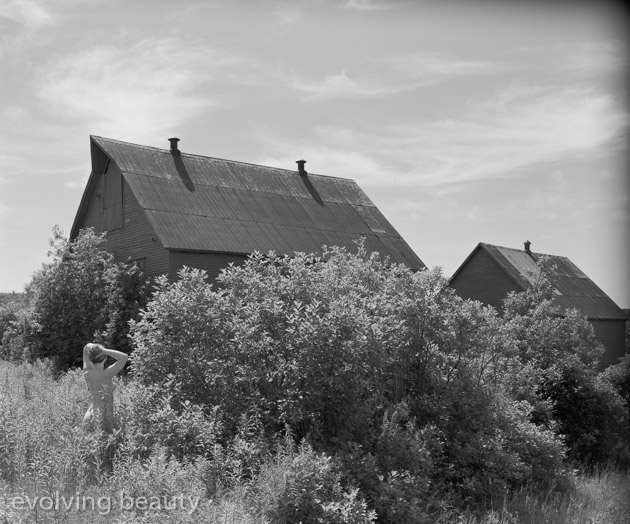The internet is a wonderful thing. Victoria and I have only worked sporadically since she moved to central Canada to work on her master's degree; in 2004 we managed a single session during a simultaneous visit to Halifax, but apart from that, the chances to work together just haven't presented themselves. Two weeks before this session however, Victoria popped up online, asking if I would be around New Brunswick in two weeks, as she was coming down for a weekend. After ten minutes to typing back and forth, our plans were laid, and after an early rise and an hour drive, I picked her up and we headed off to work together for a couple of hours.
I don't know the area around Hampton well, so we stopped in at Jamie
Wilson's to ask for suggestions for places to work (as it turned out,
Victoria 's grandmother had been photographed by Jamie's father many
years before, proving again just how small the world is). Jamie
suggested driving down the road past his place, keeping an eye on the
left, where the river ran. The advice was solid, and less than ten
minutes later, Victoria and I were working by the side of the
Kenebikasis river.
 |
| Digital infrared original, 8 frame stitch |
Thought the day was bright and sunny,
because we'd got such an early start, the light was wonderful and
angular, and as we were on the western side of the river, coming from
the same direction as Victoria would be facing, providing beautiful rim
lighting. There wasn't much flexibility possible in the way of posing,
as the river here was predominantly marsh, but the light (and model) was
beautiful, and the images came relatively quickly. The vast majority
were standing portraits (as Victoria and I have been working together
since 1998, I find the evolution of our portrait images one of the most
compelling aspects of our collaboration), but some images were more
classical images of the body set against a sweeping backdrop of the
marsh and river's edge.
Our second location along the river
was actually within the flood plane, but away from the river proper.
Here, the trees grew in a more open pattern, with rich ferns and
underbrush growing between them amonst the detritus of the spring
floods. This gave Victoria and I the opportunity to make some tree-based
images (something that is underrepresented in my work due to the
prevalence of bugs in New Brunswick, more than anything else).
 |
| Digital infrared original, 15 frame stitch |
We
started working in front of a tall, graceful tree, making both an
8"x10" negative, and a digital multi-image stitch, with several pose
being created to drop into the final image later. This is a technique I
am using more and more - making the multiple frames necessary for the
landscape, and then making the images of the model for inserting into
the final, assembled image later in the computer.I don't know the area around Hampton well, so we stopped in at Jamie
Wilson's to ask for suggestions for places to work (as it turned out,
Victoria 's grandmother had been photographed by Jamie's father many
years before, proving again just how small the world is). Jamie
suggested driving down the road past his place, keeping an eye on the
left, where the river ran. The advice was solid, and less than ten
minutes later, Victoria and I were working by the side of the
Kenebikasis river.
Thought the day was bright and sunny,
because we'd got such an early start, the light was wonderful and
angular, and as we were on the western side of the river, coming from
the same direction as Victoria would be facing, providing beautiful rim
lighting. There wasn't much flexibility possible in the way of posing,
as the river here was predominantly marsh, but the light (and model) was
beautiful, and the images came relatively quickly. The vast majority
were standing portraits (as Victoria and I have been working together
since 1998, I find the evolution of our portrait images one of the most
compelling aspects of our collaboration), but some images were more
classical images of the body set against a sweeping backdrop of the
marsh and river's edge.
Our second location along the river
was actually within the flood plane, but away from the river proper.
Here, the trees grew in a more open pattern, with rich ferns and
underbrush growing between them amonst the detritus of the spring
floods. This gave Victoria and I the opportunity to make some tree-based
images (something that is underrepresented in my work due to the
prevalence of bugs in New Brunswick, more than anything else).
 |
| 8"x10" film |
We
started working in front of a tall, graceful tree, making both an
8"x10" negative, and a digital multi-image stitch, with several pose
being created to drop into the final image later. This is a technique I
am using more and more - making the multiple frames necessary for the
landscape, and then making the images of the model for inserting into
the final, assembled image later in the computer.
The end of the session saw is exploring the possibilities offered by a
fallen trunk lying among the ferns. For this setting, I switched from
the infrared to my 8”x10” view camera, making one of my most successful
large format images of the year. As much as I like the infrared version
of the image, the large format negative captured a totally different
scene, with Victoria 's body looking delicate and sculptured among the
darker tones of the surrounding woodland floor.


















































